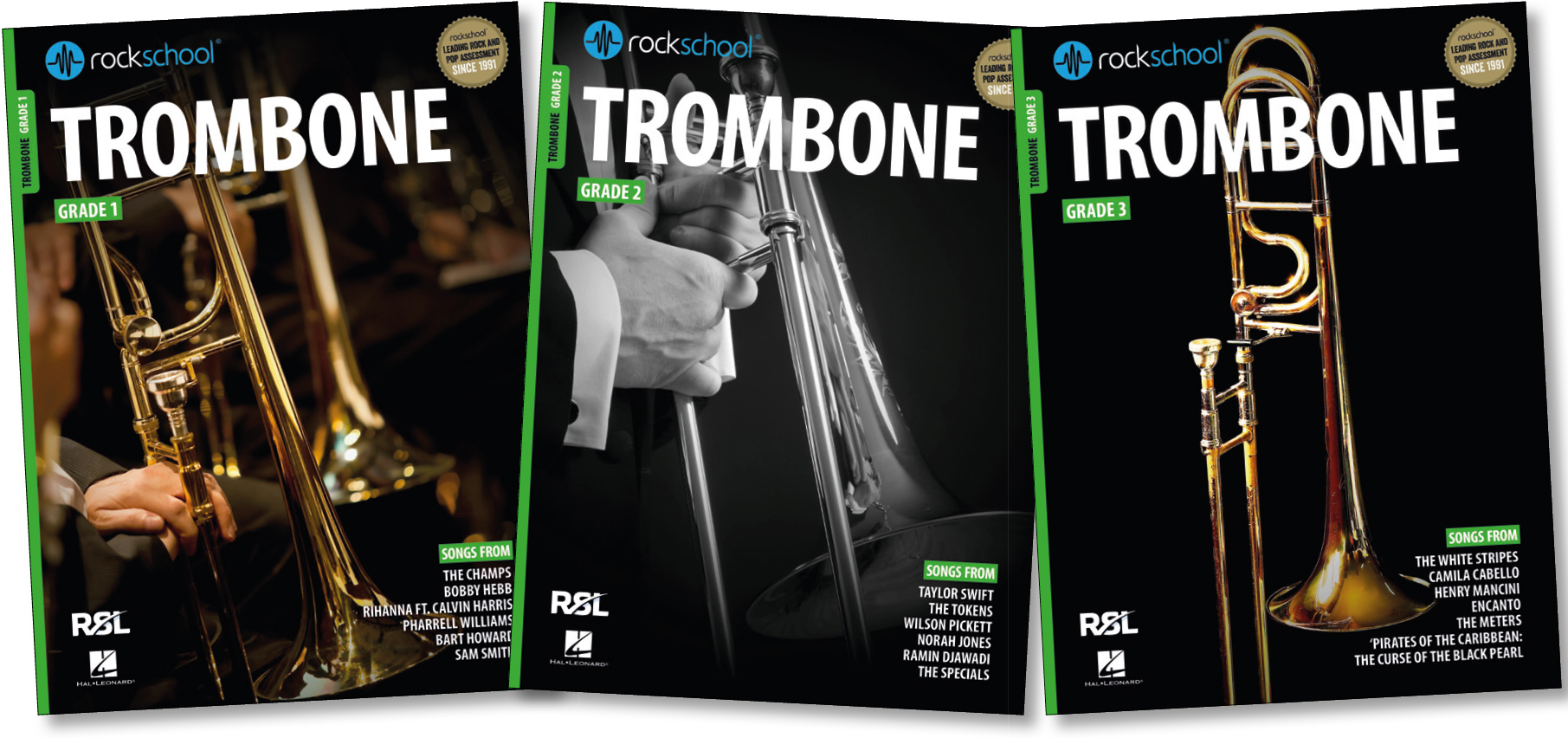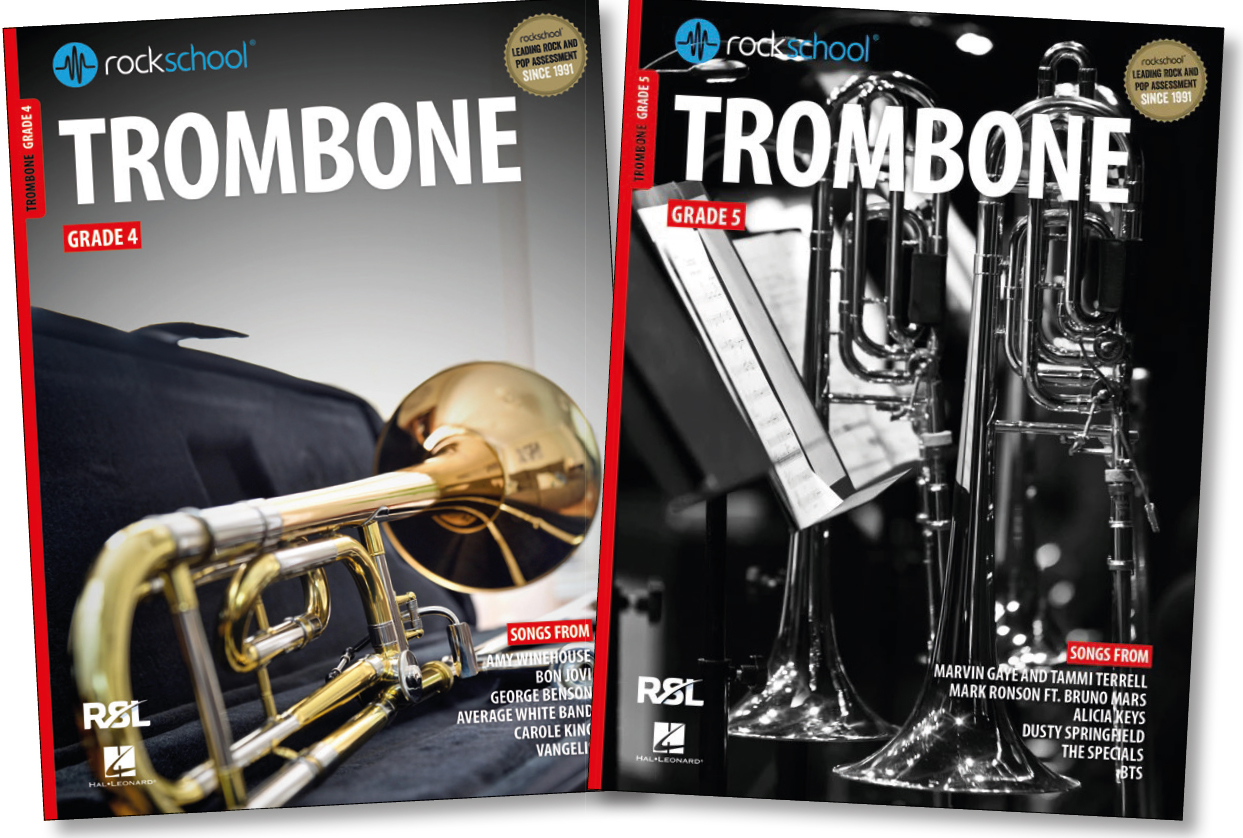
RSL Awards has launched a new set of Rockschool syllabuses for trumpet, trombone and saxophone. It marks the first time wind and brass students can take the rock-and-pop focused exams, which are billed for these instruments as Horn Section grades. The syllabuses so far cover Grades 1 to 5, with higher grades on the way.
Taken as a whole package, the requirements cover a broad range of considerations that should help develop well-rounded musicians. Each grade comes with its own syllabus book containing all the material needed to complete the exam. Graded exams require students to perform three pieces, technical exercises, a choice of sightreading or improvisation, ear tests, and to answer general musicianship questions. Alternatively, a Performance Certificate asks for five pieces and removes the other requirements.
Students can substitute some set pieces with Free Choice pieces. However, for those who stick to the book, the chance to play arrangements of ‘Hit Tunes’ with backing-tracks featuring top session musicians will be one of the major draws of these Rockschool grades. The accompanying e-books come with useful features that further enhance the backing-track experience; for example, allowing students to adjust the tempo for practice purposes or record themselves playing along to the track. Each piece is prefaced by interesting background information and details, such as the genre and release year, which provide artistic and historical context.
For all grades, ear tests and general musicianship questions make up 15% of the total mark. The ear tests ask for melodic and harmonic recall, helping develop skills which should enhance the students’ musical understanding of the pieces they are playing. The questions range from basic knowledge, like pointing to the instrument's mouthpiece in Grade 1, to questions requiring a much more mature understanding, such as giving examples of musical features typical of a chosen piece's genre in Grade 5.

Grade 1
As with all Rockschool's trombone grades, the six ‘Hit Tunes’ are at the heart of the Grade 1 syllabus. In ‘Tequila’, the mambo classic by The Champs, students will need to get to grips with the off-beat rhythms and swung quavers. This arrangement is full of different articulations. These books are excellent in their articulation markings throughout, giving important stylistic guidance.
‘I'm Not the Only One’, by Sam Smith, is a more contemporary tune requiring longer phrases and a more vocal approach. It is written in a relatively low register, down to low G, and the switches between first and sixth positions in the chorus may be difficult to navigate for younger players with a shorter reach. The other pieces are an appealing mix of older classics like ‘Fly Me to the Moon’ and more recent pop hits by the likes of Rhianna and Pharrell Williams.
The three technical studies support different technical and stylistic aspects found in the six pieces. Short subtitles like ‘Swung rhythm, articulation and the natural minor scale’ provide a useful summary of each study's focus. The studies, which have been specially written by Kieran McLeod, are another strength of these Rockschool trombone grades.
Grade 2
New genres are introduced at Grade 2, helping broaden the musical appeal. The set pieces are as diverse as the opening theme from Game of Thrones to ‘A Message to You, Rudy’, the famous ska-influenced song by The Specials. The progression from Grade 1 is clear: there are more key signatures, including those with sharps such as E major; the pieces are not all in 4/4; and rhythms are a little more advanced, including triplet crotchets at one point. However, this increase in difficulty feels manageable; for instance, the range required hasn't greatly increased.
At Grade 2, there are improvised sections in some pieces for the first time. Students less confident in improvisation can still select pieces which don't require this, just as they can choose sight-reading over improvisation in the supporting tests. Where improvisation is called for, the chord sequences progress with the keys learnt in the corresponding scales and arpeggios. This creates a demonstrable connection between the technical foundation and the more creative output, which should help students see the benefits of the technical work. The sight-reading tests also develop in line with the scales and pieces, in aspects such as key signature, range and articulations. Though the tests in the syllabus books are only indicative, the parameters for what sight-reading tests may contain are made clear.
Grade 3
The main theme from Pirates of the Caribbean, ‘He's a Pirate’, by Hans Zimmer, Klaus Badelt and Geoff Zanelli, is the first piece in compound time we meet in these grades. However, in another example of well-planned, linear progression, a Grade 2 study in 6/8 helps lay the groundwork. The trombone part requires accented forte notes up to high F, which will require improved strength and control in the high register.
The most recent piece across these grades, ‘We Don't Talk About Bruno’, from the 2021 Disney picture Encanto, features groups of semiquavers that require a more dextrous slide and improved tonguing. The technical study ‘Tonguing, blues scale transposition, and accents/marcato’ is a good exercise to help develop the technical requirements of both these pieces.
While scales and arpeggios in Grades 1 and 2 stick to the major, minor and pentatonic, modes like the mixolydian are introduced from Grade 3 onwards. The book isn't explicit if scales and arpeggios should be performed from memory, which it would be helpful to clarify in the relevant section of each syllabus.
Grade 4
The greater musical sophistication required at Grade 4 is indicated, for example, by the grace-notes in ‘Rehab’, by Amy Winehouse, or the falls in Bon Jovi's ‘Livin’ on a Prayer’. Incorporating such details into a fluent performance, while contending with the other more demanding aspects, will be key to assured performances of these songs. The improvised solos require a more advanced grasp of keys and styles, though again they can be avoided by students less confident in this area.
‘(You Make Me Feel Like) A Natural Woman’, by Carole King, is one of the relatively few slower pieces in these grades. It requires legato playing in a higher register (up to high F sharp). In a generally upbeat and punchy selection of pieces, this presents a welcome chance for students to demonstrate and work on the more lyrical side of trombone playing.
The more advanced technique expected at this level is indicated by the study ‘Double tonguing and the E major pentatonic’, which helps prepare for pieces in the next grade. Other studies help to develop breath control and articulation, essential for the more substantial repertoire to come.
Grade 5
The technical and musical challenges presented in the most advanced grade available so far are a significant step up from the earlier grades. ‘Uptown Funk’, by Mark Bronson and Bruno Mars, contains semiquaver passages with varied articulations, needing a strong and co-ordinated slide and tongue technique. The off-beat rhythms throughout demand a good feel for the funk-influenced style. To perform ‘Ain't No Mountain High Enough’, the student will need good control and stamina in the higher register. The key signature changes three times, ending in G flat major, so a more advanced grasp of musical theory would be beneficial, too.
Conclusion
The Rockschool trombone syllabuses from RSL Awards contain a well-planned selection of pieces, featuring special arrangements with high-quality backing-tracks. The choice of pieces represents a wide range of broadly non-classical genres, from contemporary pop by leading current artists to older classics from the 1950s onwards. A diverse range of popular music cultures is presented, including reggae, soul, R&B, funk, K-pop and Latin. Film and television soundtracks bring a more classical flavour.
Although the choice of six set pieces per grade is fewer than some other exam boards, likely reflecting the resources required to arrange and record them, students will find a range of styles which should have a wide appeal. The pieces tend towards the upbeat, and it will be interesting to see if later grades further exploit the melodic, singing quality at which the trombone can excel. The technical studies are well-written and musically interesting. Students would certainly benefit from working on all these studies, whether they plan to perform them in an exam or not.
It is good to see RSL Awards expanding its offer to new instruments. In doing so, it has created a valuable set of learning resources.








